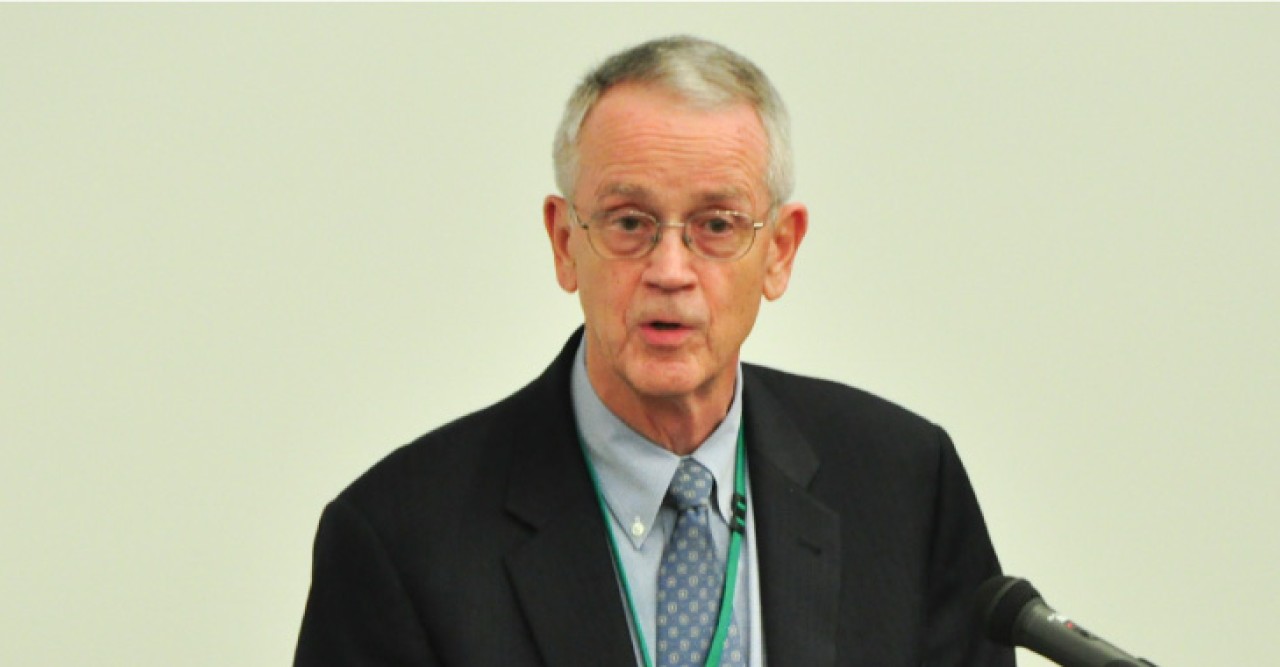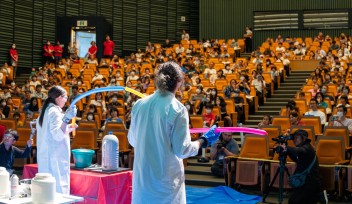A New 21st Century Research University

The Inauguration’s keynote speaker Dr. Charles Vest, President of the U.S. National Academy of Engineering, gave an inspiring speech based on his experience as past President of Massachusetts Institute of Technology (MIT). His speech highlighted the move from brain drain to brain circulation and integration as “young people are becoming global citizenship and now move around the globe studying or doing business in many different countries that present opportunities to them.” He noted that OIST is tapping into this brain circulation and integration through its vision. His conclusion consisted of six basic lessons from the experiences of 20th century research universities that a new 21st century university like OIST may wish to consider. This and more can be found in his full speech below.

I am very honored to be here in Okinawa for this grand inaugural ceremony. There can be no doubt that Okinawa, Japan, the founding boards, the Faculty, Dr. Brenner, and President Dorfan are setting off on a bold and important journey. We have every reason to believe that in due course this new university will pay strong academic, cultural, and economic dividends to the nation and prefecture.
The Massachusetts Institute of Technology (MIT) that I have served for 17 years was established 150 years ago. It was founded to be a new and different kind of institution to serve the purposes of the emerging Industrial Age in the United States.
Similarly, the Okinawa Institute of Science and Technology (OIST) has been established in the dawning decades of the 21st century to be a different kind of institution to serve the purposes of the emerging global, knowledge-based economy and interconnected world.
In the mid 20th century, we all spoke of a “brain drain.” The implication was that many of the brightest and most energetic young men and women from all over the world emigrated to the United States or western Europe where they found the most adventurous and well-funded universities in which to study or become faculty members, especially in science and engineering. These immigrants also became entrepreneurs and corporate leaders in their new country.
As we moved into the 21st century, we entered the current era of “brain circulation.” This means that bright young people now move around the globe studying or doing business in many different countries that present opportunities to them. In this spirit, OIST is building a truly international faculty. They and their students will serve the needs and meet the opportunities of Okinawa and Japan, but they will also be global citizens. This is very different from the insular, national context in which MIT was founded 150 years ago.
But I think that today we are at the beginning of an even more exciting phenomenon that I call “brain integration.” By this I mean that researchers, students, and entrepreneurs all over the world are linked together by the Internet and the World Wide Web, and they all soon will have access to massive computing power through the so-called “Cloud.” Increasingly, communities of scientists, engineers, and others in many different locations around the world will integrate their thoughts with the data and analyses of large-scale computation to solve big problems. I believe that this “brain integration” will characterize the age in which OIST will begin to make major scientific and technical contributions to humankind.
Do the concepts of “brain circulation “and “brain integration” imply that location no longer matters? Absolutely not. Where universities are located still matters. University campuses will not become obsolete just because the world is interconnected by information technology. This is true for at least three reasons. First, teaching and learning are profoundly human activities. Machines can and will enhance these processes, and they will make vast amounts of information available, but the magic that happens when students and scholars live and learn together will not be replaced. It will be greatly enhanced, but not replaced.
The second reason that location still matters is that each university will develop its own specific infrastructure for experimentation and analysis. One of the great promises of “brain integration” is that expensive equipment will not have to be duplicated on many different campuses. Rather, they can be shared in global collaborations.
The third reason that location still matters is that universities exist in cultures. I find it especially exciting that OIST will have a truly unique cultural setting. It will join together a spirit of distinctiveness and boldness in Okinawa and the Ryukyu Islands with the ancient values and disciplines of Japan. And to this mix, OIST will add contributions from the West and from a cross section of Austronesian cultures.
But to further explore why establishing a world-class university oriented to science and technology here in Okinawa is important, let me share some thoughts about the purpose of research universities.
I believe the purpose of research universities is to create Opportunity. A central objective is to provide opportunity for their graduates. Because of their education they have the opportunity to become productive citizens, to do interesting and important jobs, and to pursue the life of the mind.
But research universities also provide opportunity for business and industry. They do this by providing well-educated and well-trained employees. But even more profoundly, through their research they provide ideas for new products, processes, and services. Here again, location matters because face-to-face interactions of faculty, students, entrepreneurs, and business leaders can generate a synergy that is critically important in doing things that are new and that can be successful. My friend and colleague Desh Deshpande, a very successfully Indian-American entrepreneur, has taught me that successful entrepreneurs are people who understand the needs of real people and who have an appreciation for what will or will not work in a given culture and location.
Finally, the flow of people and ideas to and from research universities provides opportunity for prefectures, regions, and nations. This is the opportunity to enhance economies, security, and quality of life. But here I want to add one caution. Patience will be required. It is very difficult to plan and predict exactly how and when a research university will advance the economy of a region. In the U.S. no one planned Route 128 around Boston and no one planned Silicon Valley. They emerged because universities like MIT and Stanford brought smart, innovative, and adventurous faculty and students together, and because they developed strong interaction with local business people and companies. MIT and Stanford share a critically important characteristic: in them, the most fundamental research and scholarship exists side-by-side and in mutual respect with highly applied and industry-relevant research. In due course, OIST should strive for a similar balance.
As academics, we generally think primarily of the flow of new ideas and technologies from our research universities to companies. But studies show that there are other reasons that universities attract startups and other forward-looking businesses to their vicinity. They help to provide an attractive intellectual and cultural environment that improves quality of life for companies and their employees. They also tend to stimulate improvement in educational quality at all levels in their communities. In addition, they provide a stimulating and neutral venue where scientists, engineers, and business leaders can discuss topics of mutual interest. Research shows that these factors are very important to companies when companies decide where to locate businesses and laboratories.
OIST will invent its own unique features and approaches as a new research university of the 21st century. Nonetheless, I suggest six basic lessons from the experiences of research universities in the 20th century that a new 21st century university in Okinawa might wish consider.
Lesson 1: Teaching and research must be intimately intertwined.
The first lesson is that teaching and research must be intimately intertwined and must be assigned equal importance. Teaching and research are inseparable, and it is their synergy that defines the essence of a research university.
Many years ago, Fredrick Terman, then the provost of Stanford University, was asked whether he wanted Stanford to be a teaching institution or a research institution. He answered that he wanted it to be a learning institution. The Research University of the 21st century must also be devoted to learning in this broad sense – learning through discovery as well as learning through teaching and exploration of the past.
In the long run, making universities exciting, creative, adventurous, rigorous, demanding, and empowering environments is more important than the specific details of their curriculum or research program.
Lesson 2: The quality of a research university is determined by the quality of its faculty.
The second lesson is that the quality of a research university can be no better than the quality of its faculty. The faculty defines the research university. The Research University of the 21st century must strive to attract, nurture, and empower the very best professors. This essential task of building a world-class faculty will require commitment, fortitude, patience, and adherence to high academic values as well as aspirations. Some well-experienced, excellent senior professors can and are being hired at OIST, but in the end it is also important that young faculty grow up through the ranks of the university.
Lesson 3: Science can flourish only in an open environment.
Lesson 3 is that science can flourish only in an open environment. Science languishes in a closed environment. The free flow of people and ideas across institutional and political boundaries is essential to the functioning of a great university. The very process of conducting science requires that others challenge one’s hypotheses, independently verify the results of experiments, and validate theoretical conclusions. Science cannot be done in isolation. And, of course, interactions among scholars, scientists, and engineers who have diverse perspectives and varied experiences lead to creativity and innovation. Such interchange is the very essence of a research university. Maintaining an intellectually open environment requires a high degree of institutional autonomy and protection from political or ideological forces.
Lesson 4: Young faculty must be free to study and teach what they believe is important.
Lesson 4 is that it is essential to give great freedom to new, young faculty members to study and teach what they believe is important. They should not function as research assistants to senior professors. The wisdom and perspective of senior scholars is important, but most dramatic new insights and innovations come from brilliant young men and women. But with great intellectual freedom comes equally great responsibility. Thus faculty, even early in their careers, must always be held to the highest academic standards, especially through the evaluation and constructive criticism inherent in the peer review process. The freshness that comes from young faculty and from the continual flow of students to the institution is key to a great research university.
Lesson 5: Competition engenders excellence in higher education.
Lesson 5 is that competition – competition among universities to attract and retain the best faculty and students, and competition among professors and research groups in the free marketplace of ideas – engenders excellence. Such inter-institutional competition may at first seem expensive, inefficient, and complicated, especially because today universities compete on a global scale. Nonetheless, competition drives improvements in research, teaching, educational policies, working environments, facilities, and most importantly in ideas and people. Great professors attract great students, and great students attract great professors.
Lesson 6: Fundamental scholarship and research must exist on an equal plane with applied research and innovation.
Lesson 6 is that fundamental scholarship and research must exist on an equal plane with applied research and innovation. I emphasized this point earlier in this address. As we enter the 21st century, we are very aware that research universities create opportunity for nations and regions through the transfer of technology and innovation to the marketplace. Industrially relevant work is increasingly important, and an environment that is entrepreneurial also gives relevance to education.
However, there is a danger that in our rush to solve practical problems and transfer technology to industry, we could loose our bearings and forget the still more profound purposes of universities to discover truths about nature, celebrate ideas, and advance the human spirit. We must not allow universities to become overly utilitarian. Universities are places where ideas must be exchanged, evaluated, and integrated.
Even in a university like OIST that is centered on science and technology, fundamental, curiosity-driven research conducted to discover truths about nature must play a central role equal to that of research that is applied quite directly to industry and to the solution of major problems facing humankind. Both pure scholarship and applied research must be conducted with mutual respect. Both must be valued. Both must be subjected to the same rigorous standards, and they should inform each other,.
Concluding Comments
We live in an age characterized by two opposing trends – integration and fragmentation. Because of modern travel, commerce, and communications, all regions and all peoples of the earth are increasingly linked and integrated. We are also linked and integrated because we inhabit a single planet. We share its thin and fragile environment. We share its ecosystems and its finite resources. We are linked and integrated by the common desire of people everywhere to live peacefully and in good health. We are linked and integrated by our common curiosity about the world, the universe, and each other. We are linked by the knowledge and understanding developed by many people in many places, in many periods of history.
Yet at the same time, forces new and old cause us to fragment … to divide ourselves along fault lines of culture, history, geography, misunderstanding, and fear of the unfamiliar.
Those of us gathered here today share a common belief that the dominant trend of this age must be linkage and integration, not fragmentation. We believe that education, learning, discovery, and creation of opportunity will bind us together and enable us to collectively build peace and prosperity, and to face the challenges of living together on this earth. We believe that knowledge and its wise use will elevate the quality of life all around the world. We believe that science and technology can play a central, and, indeed, essential role in this quest.
For these reasons, we have much to celebrate as the Okinawa Institute of Science and Technology is launched on its journey into the future. In this Knowledge Age, the Research University of the 21st Century can and must be a great force for enlightenment, for integration, and for prosperity. The Research University of the 21st Century should not flourish only in one nation, or on one continent, or in one region. It should grow and spread its good works in all regions and on behalf of all people.
I congratulate President Dorfan and salute the forward thinking of the people of Okinawa and the Japanese government on their bold and visionary establishment of this new 21st century university. OIST has been born and will be nurtured in Okinawa. It will benefit Okinawa strongly as the years progress. But OIST will also serve the world as a global institution in the age of Brain Integration.
I wish you all good fortune on your journey, and I look forward observing the opportunity you create in the years to come.
For press enquiries:
Press Inquiry Form













